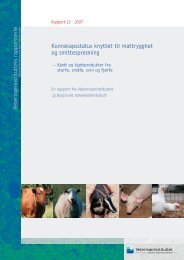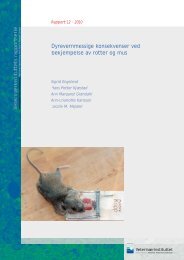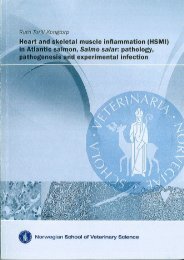Last ned fullversjon - Veterinærinstituttet
Last ned fullversjon - Veterinærinstituttet
Last ned fullversjon - Veterinærinstituttet
You also want an ePaper? Increase the reach of your titles
YUMPU automatically turns print PDFs into web optimized ePapers that Google loves.
9.2.3. Ekinokokker og andre endo- og ekto-parasitter<br />
Undersøkelse av avføringsprøve en til to ganger etter ankomst til Norge vil gi viktig informasjon om effekt<br />
av tidligere behandling og eventuelt bærertilstand for parasitter. Veterinæren må vurdere behandling mot<br />
innvollsparasitter med bredspektret anthelmentikum og dessuten mot ektoparasitter (flått, lopper og lus).<br />
Kattelopper (Ctenocephalides felis) og hundelopper (Ct. canis) er svært vanlige sørover i Europa.<br />
Kattelopper er langt vanligere enn hundelopper – også hos hund. Dersom dyrene ikke behandles mot<br />
ektoparasitter før, eller ved, import er det stor sannsynlighet for at de drar med seg lopper. Disse loppene<br />
trives, i motsetning til andre lopper, utmerket innendørs og kan bli plagsomme og vanskelige å bli kvitt<br />
dersom de etablerer seg i bolighus. Katte- og hundelopper er en viktig årsak til FAD (Flea Allergy<br />
Dermatiatis) hos hund og katt og er mellomvert for bendelmarken Dipylidium caninum.<br />
10. Referanser<br />
Baker D.G. Flynn’s Parasites of Laboratory animals. 2007; Second edition, Blackwell Publishing, Oxford,<br />
UK. Chapter 17.<br />
Bowman, D. D. and C. E. Atkins. "Heartworm biology, treatment, and control." Vet Clin North Am.Small<br />
Anim Pract. 39.6 (2009): 1127-58, vii.<br />
Cieniuch S. et al. The first detection of Babesia EU1 and Babesia canis canis in Ixodes ricinus ticks (Acari,<br />
Ixodidae) collected in urban and rural areas in Northern Poland. Polish J Microbiol 2009; 58: 231-6.<br />
Ciocan R. et al. (2010). Detection of Dirofilaria spp. in Dogs by PCR. Bulletin UASVM, Veterinary Medicine<br />
2010; 67(2)<br />
Davidson R.K. og Robertson L.J. European pet travel: Misleading information from<br />
veterinarians and government agencies. Zoonose and Public Health 2012; doi: 10.1111/j.1863-<br />
2378.2012.01499.x<br />
Dujardin J.C. et al. Spread of vector-borne diseases and neglect of leishmaniasis, Europe. Emerg Inf Dis<br />
2008; 14: 1013-1018.<br />
Dumitrache M.O. et al. Hard ticks (Ixodidae) in Romania: surveillance, host associations, and possible risk<br />
for tick borne diseases. Parasitol Res 2012; 110: 2067-2070.<br />
ESCCAP Control of parasitic insects and ticks in dogs and cats. 2009;<br />
http://www.esccap.org/uploads/docs/ogu35t0w_esccapgl3ectoguidelines.pdf (15.6.2012)<br />
ESCCAP Worm Control in Dogs and Cats. 2010;<br />
http://www.esccap.org/uploads/docs/nkzqxmxn_esccapgl1endoguidelines.pdf(15.5.2012).<br />
Folkehelseinstituttet 2012. Vurdering av risiko for folkehelsa – Linguatula serrata.<br />
http://www.fhi.no/dokumenter/6a12e57215.pdf (22.08.2012)<br />
Gray J.S. et al. Effects of Climate Change on Ticks and Tick-Borne Diseases in Europe. Interdisciplinary<br />
Perspectives on Infectious Diseases. Vol 2009; Article ID 593232, 12 pagesdoi:10.1155/2009/593232<br />
Hamel et al. Epidemiological aspects on vector-borne infections in stray and pet dogs from Romania and<br />
Hungary with focus on Babesia spp. Parasitol Res 2012; 110: 1537-1545.<br />
Ilie M.S. et al. Dirofilariosis in dog. Case report. Lucrari Siintifice Medicina Veterinara 2009; 17: 59-63.<br />
Ivana S. et al. Clinical and laboratory studies on incidence of leptospirosis in Romania. Bulletin UASVM.<br />
Vet Med 2011; 68: 179-185.<br />
<strong>Veterinærinstituttet</strong>s rapportserie 11-2012 · Sluttrapport - Importrisikovurdering av gatehunder fra Øst-Europa 26







